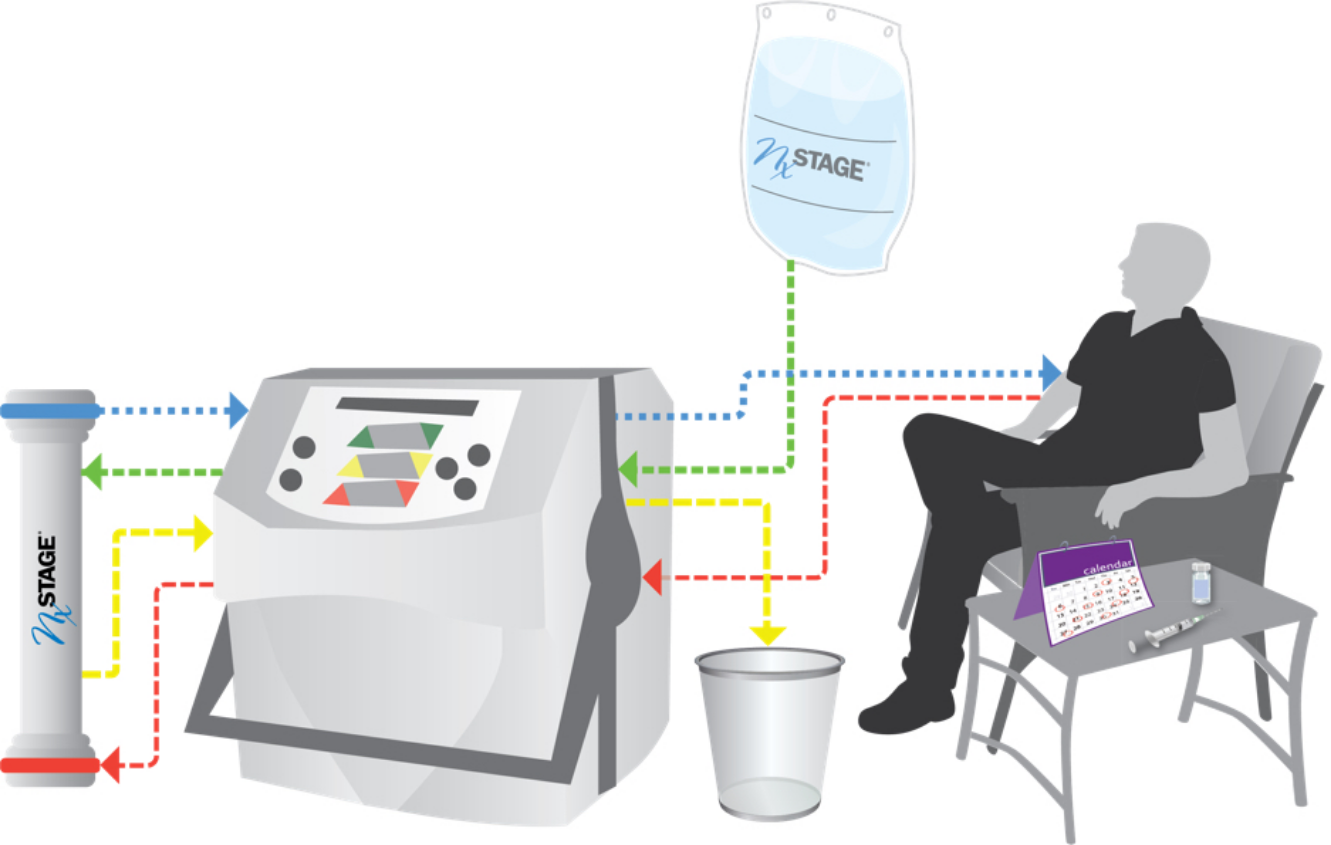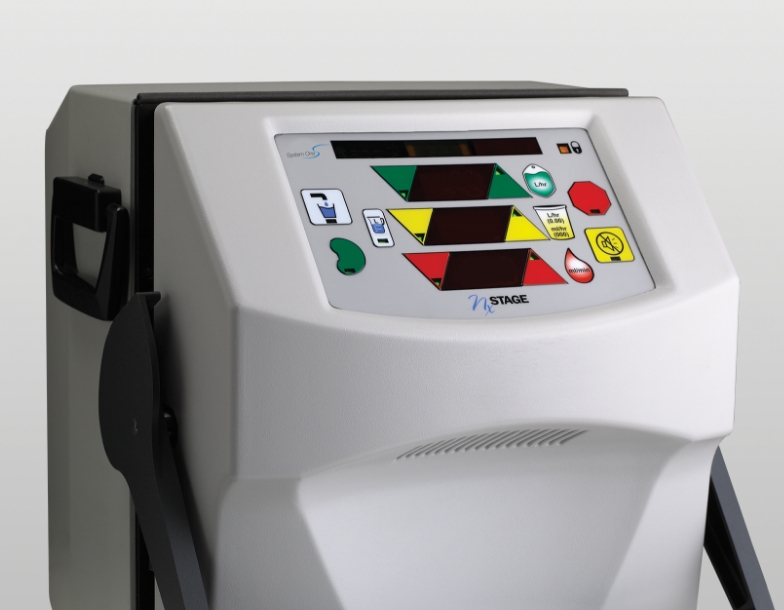Home Hemodialysis Customer Support: 866-697-8243
Peritoneal Dialysis Customer Support: 800-323-5188
Talk to a Patient Consultant About Home Dialysis: 888-200-6456
Home Hemodialysis Customer Support: 866-697-8243
Peritoneal Dialysis Customer Support: 800-323-5188
Talk to a Patient Consultant About Home Dialysis: 888-200-6456
Home Hemodialysis Customer Support: 866-697-8243
Peritoneal Dialysis Customer Support: 800-323-5188
Talk to a Patient Consultant About Home Dialysis: 888-200-6456
Home Hemodialysis Customer Support: 866-697-8243
Peritoneal Dialysis Customer Support: 800-323-5188
Talk to a Patient Consultant About Home Dialysis: 888-200-6456
The System One is the first and only truly portable hemodialysis system cleared for home hemodialysis in the United States, including solo hemodialysis during waking hours, and nocturnally while the patient and their care partner sleep. It was specifically designed for patients to use in their homes, and is small enough to allow patients to travel and bring their treatment supplies with them.
Treatment Process
NxStage System One performs a function similar to traditional in-center hemodialysis machines. It removes blood from the body, filters it, and returns the cleaned blood back to your body.
During treatment, System One cleans your blood.
Click on an icon to learn more about each step.

- Prior to starting treatment, the dialysate fluid is prepared in advance when using the PureFlowTM SL, or you can use premixed bags, as shown in this visual example, with the GREEN arrow path.
- Before or during treatment you will be asked to measure your weight, blood pressure, or administer medication.
- Blood and dialysate leave your body and pass through the filter to clean the blood, shown following the RED arrow path.
- Used dialysate, wastes and excess fluids are removed from the blood and travels through a waste line on the cartridge into a sink, toilet or drain, shown following the YELLOW arrow path.
- The cleaned blood travels back to you, shown following the BLUE arrow path.
- Before or during treatment you will be asked to measure your weight, blood pressure, or administer medication.
- Therapy is complete when the prescribed dialysate volume has been delivered.
- Daily supplies are thrown away, and the NxStage System One cycler is wiped down after use.
These steps in the treatment process will be tailored specifically to you and your needs by your doctor and care team.
Training
A training nurse at your dialysis clinic will train you on how to perform your hemodialysis treatments. Training will also be provided to a care partner, unless the patient and physician both agree that solo home hemodialysis is appropriate.
Once training begins, you will learn how to access your blood, operate the system, monitor your vital signs, administer medication, and learn what to do in the event of a medical emergency. When treating at home, you will have access to the same resources you used during training, through your care team, training materials, as well as Customer Service and Technical Support. You will be trained using a program called NxSTEPS that includes printed and online training, as well as helpful videos. This training program will help you understand what to expect and how to effectively manage your treatments.
Care Partners
Depending on their prescription, some patients may require a care partner for home hemodialysis. The trained and qualified care partner needs to be present during treatments for support and to act in the event of a medical emergency.
It is important to note that a care partner is not a medical professional. It can be a friend, spouse, relative, neighbor or another individual who is willing to be trained on the system.
Provided that both the patient and physician agree on solo home hemodialysis, having a care partner may not be a requirement to perform treatments. Additional ancillary devices and training are required to perform solo home hemodialysis.
Read more about the role of care partners in our family and friends section.
Risks and Responsibilities
Patients should review the following information carefully and discuss it with their doctors to decide whether home hemodialysis with NxStage systems is right for them.
Users should weigh the risks and benefits of performing home hemodialysis with NxStage systems.
- Medical staff will not be present to respond to health emergencies that might happen during home treatments, including, among other things, dizziness, nausea, low blood pressure, and fluid or blood leaks.
- Users may not experience the reported benefits of home, more frequent, or nocturnal hemodialysis with the NxStage systems.
- The NxStage systems require a prescription for use.
- Medical staff will not be present to perform home treatments. Users will be responsible for, among other things, equipment setup, needle insertions, responding to and resolving system alarms, system tear-down after treatment, monitoring blood pressure, ensuring proper aseptic technique is followed, and following all the training material and instructions that nurses provide.
Users will need additional resources to perform home hemodialysis.
- Users will need a trained care partner to be present during your treatment at home (unless their doctor prescribes “solo/independent” home hemodialysis, described below).
- Users must have a clean and safe environment for their home treatments.
- Users will need space in their home for boxes of supplies necessary to perform home hemodialysis with NxStage systems.
Certain forms of home hemodialysis have additional risks.
- If a doctor prescribes home hemodialysis more than 3 times a week, vascular access is exposed to more frequent use which may lead to access related complications, including infection of the site. Doctors should evaluate the medical necessity of more frequent treatments and discuss the risks and benefits of more frequent therapy with users.
- If a doctor prescribes “solo/independent” home hemodialysis without a care partner during waking hours, risks of significant injury or death increase because no one is present to help users respond to health emergencies. If users experience needles coming out, blood loss, or very low blood pressure during solo/independent home hemodialysis, they may lose consciousness or become physically unable to correct the health emergency. Users will need additional ancillary devices and training to perform solo/independent home hemodialysis.
- If a doctor prescribes “nocturnal” home hemodialysis at night while the user and a care partner are sleeping, risks increase due to the length of treatment time and because therapy is performed while the user and a care partner are sleeping. These risks include, among other things, blood access disconnects and blood loss during sleep, blood clotting due to slower blood flow or increased treatment time or both, and delayed response to alarms when waking from sleep. A doctor may need to adjust users’ medications for nocturnal home hemodialysis, including, among other things, iron, Erythropoiesis-Stimulating Agents (ESA), insulin/oral hypoglycemics, anticoagulants, and phosphate binders.
The reported benefits of peritoneal dialysis may not be experienced by all patients.
Peritoneal dialysis does involve some risks that may be related to the patient, center, or equipment. These include, but are not limited to, infectious complications. Examples of infectious complications include peritonitis and exit-site and tunnel infections. Non-infectious complications include catheter complication such as migration and obstruction, peritoneal leaks, constipation, hemoperitoneum, hydrothorax, increased intraperitoneal volume, and respiratory and gastric issues. It is important for healthcare providers to monitor patient prescriptions and achievement of adequate fluid management goals.
Patients should consult their doctor to understand the risks and responsibilities of performing peritoneal dialysis.
APM2099 Rev. E
350 Merrimack Street
Lawrence, MA 01843
United States
350 Merrimack Street
Lawrence, MA 01843
United States
920 Winter Street
Waltham, MA 02451
United States
920 Winter Street
Waltham, MA 02451
United States
1-866-NxStage (697-8243)
1-866-NxStage (697-8243)
© 2025 Fresenius Medical Care. All Rights Reserved.
© 2025 Fresenius Medical Care. All Rights Reserved.


